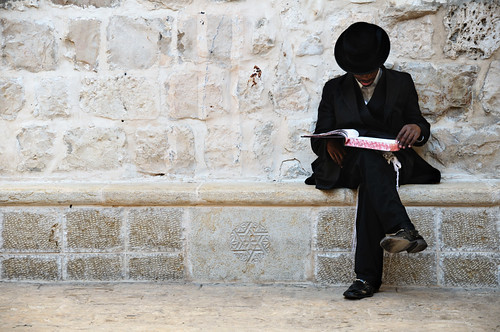Analyzing the Literature
Many of us across the spectrum of Orthodoxy enjoy mocking Charedi popular literature. We giggle at this self-contradiction or that historical inaccuracy. It’s fun, easy and reinforces our self-image as intellectuals but it ignores the purposes those perceived flaws serve.
 Dr. Yoel Finkelman takes the literature much more seriously. In his magnificent recent book, Strictly Kosher Reading: Popular Literature and the Condition of Contemporary Orthodoxy, he analyzes the goals and methods of Charedi popular literature and what they say about the community in general. Finkelman’s topic of study is quite limited — English books published by or for Charedim, and occasionally magazines and newspapers. However, within this subject his reach is broad.
Dr. Yoel Finkelman takes the literature much more seriously. In his magnificent recent book, Strictly Kosher Reading: Popular Literature and the Condition of Contemporary Orthodoxy, he analyzes the goals and methods of Charedi popular literature and what they say about the community in general. Finkelman’s topic of study is quite limited — English books published by or for Charedim, and occasionally magazines and newspapers. However, within this subject his reach is broad.
He begins by stating his own goals, methods and biases. He then proceeds to a number of different subtopics — such as the different strategies authors adopt to merge secular and Jewish culture, how they criticize the community, and how they protect the community. He examines multiple genres — fiction, theology, history, cookbooks, and more. All the while, he is cognizant that the Charedi community is not monolithic. Different authors related differently to community, authority and tradition.
II. Coalescence, Filtering & Monopolizing
Charedi popular literature brings secular ideas into the community, adopting them as positive Jewish values. Whether books are about nutrition, psychology or marital counseling, they take ideas from the cultural highway and dress them in Torah clothing. A prime example is R. Lawrence Kelemen’s parenting guide, To Kindle A Soul: Ancient Wisdom for Modern Parents and Teachers, which adopts contemporary ideas that directly contradict traditional Jewish sources and yet portrays this new approach as Torah-based.
The literature also serves as a filter, allowing into the community only those outside ideas that are deemed inoffensive. For example, marriage guides adopt secular attitudes to relationships while maintaining Charedi dating standards and omiting discussions of marital relations that violate communal norms.
By publishing Charedi versions of secular popular literature, the community is able to monopolize culture. There is a total Charedi experience that does not require access to external media. Community members use their own news websites, enjoy their own music and read their own self-help books.
III. Under Siege
As a distinctive minority in a socially powerful culture, Charedim define who they are both in positive and negative ways. They consider their community to be a continuation of timeless Jewish communities of the past, with eternally true values that clash with the falsity of today’s majority culture. The communication of this message is so important that its bearers exaggerate, and sometimes prevaricate, in order to define the nature and boundaries of their community. The European shtetl (small town) is portrayed as a religious ideal which today’s cloistered Charedi communities attempt to mirror. Finkelman examines the various methods in which Charedi historians and biographers create an aspirational past that reflects contemporary Charedi values in order to define today’s community.
Similarly, the majority culture is consistently portrayed as evil. Community members must not only be scared of the dangers lying outside their world but must see their community as superior. This standard practice among cultural minorities can be seen prominently in Charedi popular theological works. They emphasize the rational basis of Charedi beliefs and cast as dishonest and/or hopelessly biased all who fail to reach their conclusions.
IV. Theological Comparisons
Dr. Finkelman’s book is not long but it is thick with ideas. Every page contains nuggets fit for a full Shabbos table discussion, with not only data and examples but also the ample insight of a sober, respectful, religiously knowledgeable, trained academic. There is so much in the book, both with which to agree and disagree, that I choose the following example with great difficulty.
In the context of his discussion of Charedi popular theology, which is very rationalist in its approach, Finkelman compares it in general to Medieval Jewish rationalist theology and contemporary Modern Orthodox theology. He notes that the Medievals were elitists who participated fully in the science/philosophy of their day. To them, philosophical investigation is a primary religious activity. In contrast, Charedi popular theologians teach their simplified philosophy to the masses as important only to those who need it, and largely ignore mainstream science and philosophy, focusing instead on the fringe of the scientific community.
Modern Orthodox theology “thrives on inherent ambiguity” and “openly acknowledges adopting contemporary values, albeit selectively.” It rejects proofs and instead bases its faith on religious experience and intuition. It also acknowledges disputes in Jewish theology. In contrast, Charedi popular theology is straightforward and clear. It homogenizes Jewish thought and claims to entirely reject secular values.
Despite this comparison’s attraction, it is to some degree unfair to set the greatest Medieval and contemporary Modern Orthodox theologians against Charedi popular theologians. We should instead look to the greatest Charedi theologians. However, while we will find more depth and nuance, I believe we will still find the same general trends.
V. Conclusion
Dr. Yoel Finkelman’s Strictly Kosher Reading is an important book that is both fun and thought-provoking. It seriously studies a significant aspect of the Jewish community that has been often discussed partially without the kind of sustained thought and analysis that Finkelman finally provides. This is the must-read book of year for every “hocker” and armchair critic in the Orthodox community. {http://torahmusings.com/2011/10/charedi-popular-literature/}
No comments:
Post a Comment